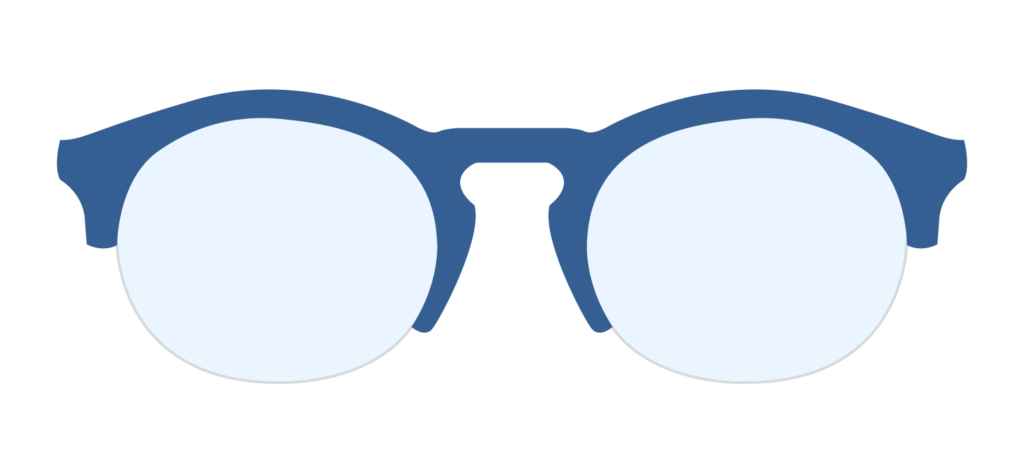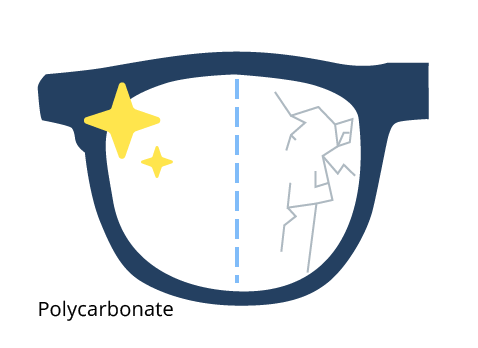Which Types of Glasses, Frames, & Lenses is Best For You?
Have you ever wondered how your glasses could enhance your lifestyle beyond just improving your sight?
Do you know which lens material offers the best durability and clarity for your daily activities? With an array of options available, from lightweight polycarbonate lenses to stylish metal frames, making an informed choice can significantly impact your visual experience and comfort.
Join us as we break down the essentials, providing you with the knowledge you need to make the best choice for your eyes. Discover the perfect blend of functionality and fashion in eyewear.

Types of Glasses
Glasses come in two main categories: prescription and non-prescription. Understanding the functionalities, advantages, and disadvantages of each can help you make an informed decision based on your needs.
Prescription Glasses
Prescription glasses are tailored to correct vision issues like nearsightedness, farsightedness, astigmatism, and presbyopia. They come in various types, each designed to cater to specific needs. Here’s an overview of the main types, their functionalities, pros and cons, and sample uses.

Single Vision Glasses
Functionality: These glasses have a single prescription power across the entire lens. They’re designed to correct a single vision problem, such as difficulty seeing up close or far away.
Pros:
- Simple and effective for a specific vision correction
- Generally more affordable than other types
Cons:
- Not suitable for those who need multiple focal points corrected
Sample Uses: Ideal for people under 40 who need glasses for reading or distance but not both.

Bifocal Glasses
Functionality: Bifocals contain two different prescriptions in one lens, separated by a visible line. The top part corrects distance vision, while the bottom part is for reading or seeing objects up close.
Pros:
- Convenient for those needing both distance and near vision correction without switching glasses
Cons:
- The visible line can be distracting
- Limited field of view for each prescription area
Sample Uses: Suitable for individuals over 40 who experience presbyopia and need correction for both reading and distance.

Progressive Lenses
Functionality: Progressives provide a seamless transition between multiple prescriptions in one lens, from distance correction at the top to near correction at the bottom, with an intermediate area in between.
Pros:
- No visible lines, offering a more natural vision correction experience
- Corrects for distance, intermediate, and near vision
Cons:
- Adjustment period required for some users
- Can be more expensive than single vision or bifocal lenses
Sample Uses: Perfect for those who need multifocal correction but want a more aesthetically pleasing option than bifocals.

Computer Glasses
Functionality: Specifically designed to reduce eye strain from computer screens, these glasses have a prescription optimised for intermediate and near distances common in computer work.
Pros:
- Helps reduce eye strain and discomfort from prolonged screen time
- Can include blue light filtering to protect eyes
Cons:
- Not suitable for general use outside computer and desk work
Sample Uses: Ideal for office workers or anyone who spends significant time in front of a computer.

Transition Lenses (Photochromic)
Functionality: These lenses automatically darken in response to sunlight and return to clear indoors, providing both prescription correction and sun protection.
Pros:
- Convenient for moving between indoors and outdoors
- Offers UV protection
Cons:
- May not transition as well in cars due to UV blocking windshields
- Can be more costly than standard lenses
Sample Uses: Ideal for office workers or anyone who spends significant time in front of a computer.
Non-Prescription Glasses
Non-prescription glasses are designed for people who don’t require vision correction but still want to wear glasses for fashion, eye protection, or to reduce eye strain from screens. Here are the main types, their functionalities, pros and cons, and sample uses.

Reading Glasses
Functionality: Reading glasses offer magnification to help with reading up close for those experiencing presbyopia or eye strain from near tasks. They do not correct vision but make it easier to see small print or objects at close range.
Pros:
- Affordable and readily available
- Can reduce eye strain during close work
Cons:
- One-size-fits-all approach may not be suitable for everyone
- Not customised to individual eye health needs
Sample Uses: Ideal for older adults or anyone needing a little help with close-up vision tasks like reading or crafting.

Computer/Blue Light Blocking Glasses
Functionality: These glasses are designed to filter out blue light emitted by digital screens, aiming to reduce eye strain and improve sleep quality. They have a special coating that reflects blue light.
Pros:
- Can reduce digital eye strain and discomfort
- May improve sleep patterns by reducing blue light exposure before bedtime
Cons:
- Benefits of blue light blocking are still debated among experts
- Not necessary for everyone, depending on screen exposure and sensitivity
Sample Uses: Suitable for individuals who spend a lot of time on computers, smartphones, or tablets, especially in the evenings.

UV Protection Sunglasses
Functionality: Non-prescription sunglasses designed to protect the eyes from harmful UV rays. They come in various styles and levels of UV protection.
Pros:
- Protects eyes from UV damage
- Fashionable and can complement personal style
Cons:
- Quality of UV protection varies widely
- Some may prioritise fashion over effective eye protection
Sample Uses: Essential for everyone when outdoors, especially during sunny days or at high altitudes where UV exposure is greater.

Fashion Glasses
Functionality: Glasses with clear, non-prescription lenses intended purely for aesthetic reasons or to accessorise an outfit.
Pros:
- Can enhance personal style
- Wide range of designs to suit any look
Cons:
- No vision correction or eye protection benefits
- Quality can vary, with some being more fragile
Sample Uses: Perfect for those who want the look of glasses as a fashion statement or part of their personal branding without needing vision correction.
Whether you need prescription glasses to correct your vision or non-prescription glasses to protect your eyes and enhance your style, there’s a wide range of options available to meet your needs.
The key is to understand your specific needs—whether it’s vision correction, eye protection, or fashion—and choose glasses that best meet those requirements.
Types of Frames
Choosing the right frame for your glasses is crucial not only for comfort and functionality but also for how you present yourself to the world. Frames come in various materials, shapes, and styles, each with its unique benefits and drawbacks. Here’s a straightforward look at the main types of frames and what they offer, giving you the insights needed to navigate the options available from different frame brands:

Metal Frames
Functionality: Metal frames are durable and resistant to corrosion. They often come in classic styles and can be adjusted for a better fit.
Pros:
- Strong and long-lasting
- Sleek and professional appearance
- Hypoallergenic options available, like titanium
Cons:
- Can be more expensive than other materials
- May need regular adjustments to maintain fit
- Some metals may cause skin reactions in sensitive individuals
Sample Uses: Ideal for older adults or anyone needing a little help with close-up vision tasks like reading or crafting.

Plastic Frames
Functionality: Plastic frames are lightweight and come in a variety of colours and styles, offering more room for personal expression.
Pros:
- Wide range of colours and designs
- Generally more affordable than metal frames
- Comfortable for long wear due to their light weight
Cons:
- Can break more easily than metal frames
- May lose shape over time, requiring replacement
Sample Uses: Perfect for those looking to express their personality through their eyewear or for anyone seeking a budget-friendly option.

Acetate Frames
Functionality: Acetate frames are a type of plastic frame but are higher quality, made from renewable materials, and offer richer colours and textures.
Pros:
- More durable and flexible than standard plastic
- Vibrant colours and patterns for unique styles
- Hypoallergenic
Cons:
- Can be more expensive than standard plastic frames
- Still not as durable as metal frames
Sample Uses: Suitable for fashion-forward individuals and those with skin sensitivities looking for stylish, comfortable eyewear.

Rimless Frames
Functionality: Rimless frames have no frame around the lens, offering a minimalistic look. The lenses are attached directly to the bridge and temples.
Pros:
- Lightweight and almost invisible on the face
- Unobstructed view
- Versatile style compatibility
Cons:
- Less durable; lenses are more prone to damage
- Can be more expensive due to specialised construction
Sample Uses: Ideal for those who prefer a subtle, barely-there look or want to minimise the appearance of their glasses.

Semi-Rimless Frames
Functionality: Semi-rimless frames have a frame over the top of the lens but not the bottom, providing a balanced look between classic and minimalist styles.
Pros:
- Less obtrusive than full frames while offering more protection than rimless designs
- Stylish and can highlight the eyes without overpowering the face
Cons:
- May not be as durable as full-framed glasses
- Limited style variations compared to full-frame and rimless options
Sample Uses: Great for those who want to combine the durability of full frames with the subtlety of rimless glasses.
When choosing frames, consider your lifestyle, personal style, and the level of care you’re willing to invest in maintaining your glasses.
Types of Lenses
The lenses in your glasses are as crucial as the frames, if not more so, because they directly impact how you see the world. Different types of lenses serve various purposes, from correcting vision to protecting your eyes. Here’s a straightforward overview of the main types of lenses, their functionalities, pros and cons, and sample uses:

Single Vision Lenses
Functionality: These glasses have a single prescription power across the entire lens. They’re designed to correct a single vision problem, such as difficulty seeing up close or far away, known as short-sightedness and long-sightedness.
Pros:
- Simple and effective for people who need correction for one type of vision
- Generally the most affordable lens option
Cons:
- Not suitable for those who need multifocal vision correction
Sample Uses: Ideal for individuals who only need glasses for driving, computer work, or reading.

Bifocal Lenses
Functionality: Bifocal lenses have two distinct optical powers – one for distance at the top and one for reading at the bottom, separated by a visible line.
Pros:
- Allows the wearer to see clearly at both distance and near without needing two pairs of glasses
Cons:
- The line can be visually distracting, and adapting to the lens can take time
- Limited field of view for each section
Sample Uses: Suitable for people over 40 who have presbyopia and need glasses for both reading and distance. Knowing your pupillary distance is critical when selecting lenses, especially for bifocals or progressives, to ensure the correct alignment and maximisation of your vision potential.

Progressive Lenses
Functionality: Progressive lenses offer a smooth transition between multiple focal points, from distance at the top to reading at the bottom, without visible lines.
Pros:
- No visible lines, providing a more natural way of seeing at different distances
- Corrects for near, intermediate, and distance vision
Cons:
- Can be more expensive than single vision or bifocal lenses
- Some people may experience difficulty adapting to the different fields of vision
Sample Uses: Perfect for individuals who need multifocal correction but want a lens that looks like a single vision lens.

Polycarbonate Lenses
Functionality: Polycarbonate lenses are impact-resistant and thinner and lighter than standard plastic lenses, making them ideal for children, sports eyewear, and safety glasses.
Pros:
- High impact resistance ensures safety in active situations
- Offers UV protection
Cons:
- More expensive than standard plastic lenses
- Some may notice a slight distortion due to the material’s properties
Sample Uses: Recommended for children’s eyewear, athletes, or anyone with an active lifestyle needing durable lenses. This material is also beneficial for those with a phoria eye condition, providing the necessary protection without the added weight.

Photochromic Lenses
Functionality: Photochromic lenses automatically adjust their level of tint based on light conditions, darkening in bright sunlight and clearing up indoors.
Pros:
- Convenient for those who move frequently between indoors and outdoors
- Offers UV protection
Cons:
- May not darken adequately inside cars because UV light is blocked by windshields
- More expensive than standard lenses
Sample Uses: Ideal for everyday wear, especially for people who do not want to switch between prescription glasses and sunglasses.
Each lens type offers unique benefits tailored to different needs, whether it’s vision correction, eye protection, or convenience. Understanding the pros and cons of these lenses will help you make an informed decision about which is best suited for your lifestyle and vision requirements. Choosing the right lenses is essential to ensure clear vision, comfort, and eye health.
How to Choose the Right Type of Glass, Frame & Lens
Selecting the right eyewear involves more than just style; it’s about comfort, function, and how well it suits your lifestyle. Here’s a straightforward guide, enriched by the insights you can gain from optometry services, to assist you in navigating the vast options and finding the best fit for your vision needs and personal style
01.
UNDERSTAND WHAT YOUR VISION NEEDS
Vision Correction: Start with your prescription. Know if you need single vision lenses for specific activities (like reading or distance), bifocals, or progressives for multiple vision corrections.
Eye Protection: Consider if you need lenses that protect against UV rays, blue light from screens, or impact-resistant materials for sports

02.
CHOOSE THE IDEAL FRAME
Face Shape: Select a frame shape that complements your face. Round faces look good in square frames, while angular faces can be softened with rounder frames.
Material: Decide based on your activity level and comfort. Metal frames are durable and classic, while plastic or acetate frames offer more colours and designs. If you’re active, consider lightweight and impact-resistant materials.
Comfort & Fit: Make sure the frames fit well without pinching your nose or squeezing your temples. They should stay in place when you move your head.

03.
SELECT THE RIGHT LENS MATERIAL
Polycarbonate: Ideal for children or anyone active due to its impact resistance
High-Index Plastic: Best for strong prescriptions because it can be thinner and lighter
Glass: Offers excellent clarity but is heavier and can shatter more easily
04.
FIND THE BEST LENS COATINGS AND ADD-ONS
Anti-Reflective Coating: Reduces glare, beneficial for driving and computer use.
Photochromic Treatment: Lenses that darken in sunlight, a good option for those who frequently move between indoors and outdoors.
UV Coating: Protects your eyes from harmful UV rays.
05.
CONSIDER YOUR LIFESTYLE
Daily Activities: Your routine activities can dictate your choice. If you spend long hours at a computer, consider blue light blocking lenses. For outdoor activities, UV protection and durability are key
Fashion vs. Function: Decide what’s more important to you. While style is significant, don’t compromise on comfort and functionality.
Budget: Prices vary widely based on the type of glasses, frames, and lenses. Decide on a budget beforehand but remember that investing in good quality eyewear can save you money in the long run.

Choosing the right eyewear is a balance between your vision needs, lifestyle, and personal style. By understanding these aspects and consulting with an eye care professional, you can find the perfect glasses that not only correct your vision but also fit your life and look great.
FAQs About the Types of Glasses
Your prescription lens type is determined by your vision correction needs. Single vision lenses are for one type of correction (distance, intermediate, or near). Bifocals are for two different ranges, typically near and distance. Progressive lenses offer a gradual change for near, intermediate, and distance vision without visible lines. Your eye care professional can recommend the best option based on your prescription and lifestyle.
Metal frames are durable, often adjustable, and offer a classic or professional look. They can be more expensive and sometimes cause skin reactions in sensitive individuals. Plastic frames are lightweight, come in various colours and styles, and are generally more affordable. However, they may break more easily than metal frames and can lose shape over time.
Absolutely. Many eyewear options combine style with functionality. Acetate frames, for example, offer durability and a unique look with a wide range of colours and patterns. Photochromic lenses provide convenience and protection while maintaining the style of your frames. It's about finding the right balance that suits your personal taste and meets your vision needs.
If you spend significant time in front of digital screens, computer glasses can be beneficial. They're designed to reduce eye strain and block blue light, potentially improving sleep quality. While the benefits of blue light blocking are debated, many users report reduced eye strain and discomfort.
Generally, choose a frame that contrasts with your face shape. Square frames suit round faces by adding contrast, while round or oval frames can soften the angles of a square or rectangular face. The size of the frame should be in scale with your face size. An eyewear professional can help you select the most flattering style.
Photochromic lenses automatically adjust their tint based on the light conditions. They darken in bright sunlight to protect your eyes and clear up indoors or in low light, providing a comfortable vision in various settings. They're made with special materials that react to UV light, making them convenient for people who move between indoors and outdoors frequently.
UV coating on lenses protects your eyes from harmful ultraviolet rays, which can contribute to cataracts and other eye health issues. While not everyone may prioritise UV coating, it's highly recommended for outdoor use and general eye health, especially in environments with high sun exposure.
The frequency of replacement depends on changes in your prescription, the condition of your lenses and frames, and whether your eyewear meets your current needs. An annual eye exam is recommended to assess your vision and prescription. If your frames or lenses are damaged, or your prescription has changed, it's time for new glasses.
Yes, you can combine different coatings on your lenses, such as anti-reflective, UV protection, and scratch-resistant coatings. Discuss with your eye care provider which combinations would best suit your lifestyle and vision needs.
Proper care includes cleaning your lenses with a microfiber cloth and lens cleaner, storing your glasses in a protective case when not in use, and avoiding leaving them in hot cars or places where they can get damaged. Regular adjustments by an eyewear professional can also help maintain their fit and comfort.




